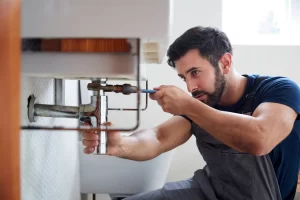How to Repair a Running Toilet
 A running toilet is a common household plumbing issue that can waste significant amounts of water, increase your utility bills, and cause frustration. The good news is that fixing a running toilet is often straightforward and can usually be done without the need for professional help.
A running toilet is a common household plumbing issue that can waste significant amounts of water, increase your utility bills, and cause frustration. The good news is that fixing a running toilet is often straightforward and can usually be done without the need for professional help.
Why Does a Toilet Run?
A toilet continues running when water constantly flows from the tank to the bowl, failing to stop as it should after a flush. This issue is often caused by:
A Faulty Flapper: The rubber or plastic flapper inside the tank might not be sealing properly, allowing water to continuously escape into the bowl.
Problems with the Float: The float controls the water level in the tank. If it’s set too high or is damaged, it can cause water to overflow into the overflow tube.
A Malfunctioning Fill Valve: The fill valve controls how much water enters the tank after a flush. If it’s not working correctly, it can cause continuous water flow.
Turn Off the Water Supply
Before beginning any repairs, locate the shut-off valve behind or beneath the toilet and turn it off. This prevents water from entering the tank while you work. Flush the toilet to empty the tank, and use a towel or sponge to remove any remaining water.
Inspect the Flapper
The flapper is a rubber seal at the bottom of the tank that controls water flow to the bowl.
Check for Damage: Remove the flapper and inspect it for signs of wear, cracks, or warping. If it’s damaged, replace it with a new one, which can be found at any hardware store.
Ensure Proper Alignment: If the flapper is in good condition, ensure it’s properly seated over the flush valve opening. Adjust the chain length, so the flapper opens and closes fully without being too tight or too loose.
Adjust the Float
If the tank overfills, water will flow into the overflow tube, causing the toilet to run.
Ball Float: If your toilet has a ball float, bend the metal arm downward slightly to lower the water level.
Cup Float: For cup floats, slide the float down the rod to reduce the water level. Adjust it, so the water stops about 1 inch below the top of the overflow tube.
Check the Fill Valve
Clean the Valve: Debris inside the valve can cause it to malfunction. Remove the valve cap and rinse it under running water to clear any buildup.
Replace the Valve: If cleaning doesn’t resolve the issue, or if the valve is visibly damaged, replace it. Replacement fill valves are affordable and come with installation instructions.
Test the Toilet
Once you’ve made the necessary adjustments or replacements, turn the water supply back on and allow the tank to refill. Flush the toilet and observe:
Ensure the flapper seals tightly after the flush.
Confirm the float stops the water at the correct level.
Listen to ensure the water stops running completely.
When to Call a Professional
If you’ve tried the above steps and your toilet is still running, or if you encounter more complex issues such as a cracked tank or persistent leaks, it’s time to call a plumber. A professional can diagnose and resolve the problem efficiently, saving you time and frustration. Call Emergency Plumber in Bournemouth. We are your right contact partner.
